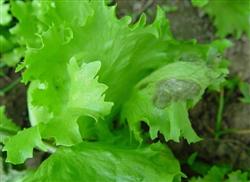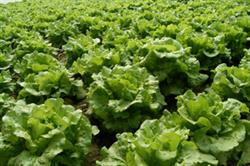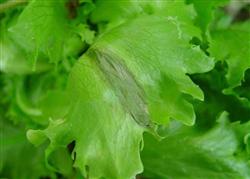Characteristic description and control methods of lettuce rot

Pathogen Pseudomonas cichorii,P.marginalis,P.viridiflava symptoms, also known as lettuce pseudomonas rot or bacterial leaf spot, is a bacterial disease. The plants in the early heading stage were prone to disease, at first, the leaf margin was flooded, and gradually changed from light brown to dark green, part of the mesophyll tissue withered and the leaves shrunk. During the heading stage, a light brown water-immersed spot appeared in the outer leaf midvein or leaf margin, and soon the leaf vein browned and expanded rapidly, but there was no mildew layer. The inner leaves browned and soft rotted, and the surface of the bulb was covered with thin paper browning and dead leaves. The pathogen overwintered on the remnant of the diseased plant, lived in the soil for more than one year, and was transmitted through the soil. It was spread by Rain Water and irrigation water and pests in the field, and the optimum temperature of the disease was 25 ~ 27 ℃. The disease is easy to occur in low temperature season and continuous rainy weather, and the disease increases rapidly when the harvest is delayed. In addition, continuous cropping can promote the occurrence of diseases. Therefore, it is necessary to avoid continuous cropping in frequently-affected plots in the previous year. Control methods ① agricultural measures immediately remove and burn diseased plants, carry out high border cultivation, strengthen field drainage, and harvest at the same time. In the initial stage of ② control, 47% Ruinong wettable powder was used, or 78% Bo ·mn-Zn wettable powder, or 40% bacterial quick gram wettable powder, or 14% complex ammonia copper water, or 50% carbendazim soluble powder, or 60% copper ethyl succinate, aluminum and zinc wettable powder, or 72% agricultural streptomycin sulfate soluble powder 3000 times. Or 53.8% can kill dry suspension 1000 times liquid and other chemical spray control. Spray once every 7 days, continuous prevention and treatment for 2 or 3 times.
- Prev

High-yield cultivation techniques of lettuce
Lettuce seeds are grayish white or dark brown achenes, with a thousand seeds weighing about 0.8 to 1.2 grams. Before sowing, 70% dimethazone was used to treat the seeds at 0.3% of the seed weight. Lettuce seed germination requires a lower temperature, about 4 degrees Celsius seeds can germinate, so it can be sown in late March. Before sowing, the seedling bed was watered thoroughly.
- Next

Control of lettuce rot
The disease is mostly infected from the petiole or root of the rhizome, and it is initially water-stained yellowish brown soft rot with a foul smell. Sometimes soft rot begins at the edge of the outer leaf or at the top of the bulb, and in severe cases the root pith and bulb rot. Germs spread through watering or insects, invading from the wounds and cracks of the plant. The optimum temperature for disease occurrence is 2.
Related
- Where is it suitable to grow horseradish in China? it is expected to see the middle altitude horseradish in Alishan.
- How to prevent tomato virus disease reasonably? (Control methods included)
- Many people like to plant towel gourd on the balcony. What are the main points of this method and management?
- What crops can chili peppers be mixed with?
- Fertilization techniques and matters needing attention in Tomato
- What are the grafting techniques for peach seedlings in spring?
- Harm and control methods of root swelling disease of Chinese cabbage
- What are the pests of sweet potatoes? How to prevent and cure it?
- Symptoms, causes and Control methods of navel Rot in Tomato
- The cause of "Cucumber rotten bibcock" in Farmers' planting Cucumber and its Control Plan

